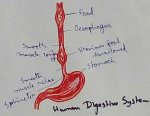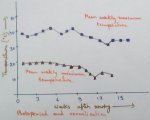Dry Electrical Cell
A dry electrical cell is a small cylindrical or box shaped container full of some chemical mixture. It can generate low power electrical energy. We commonly call it a battery.
A battery is made up of a hollow cylindrical zinc container with one end open. It is filled with a mixture of ammonium chloride paste, dust of manganese dioxide and graphite. A carbon rod is inserted through the centre of the mixture. The bottom of the carbon rod is kept a little above the base of the zinc container. A brass cap is fitted at the top of the carbon rod. The upper part Cross Section of a Battery of the container is first sealed with molten bitumen and then with a plastic lid. The plastic lid has a hole at its centre, through which the brass cap emerges out. After that the outer zinc container is wrapped with thick paper and then with a metal sheet. The cell is now ready for use. Batteries are commonly used in torches, radios, calculators, time pieces, tape recorders, electrical toys etc.
Now we
will discuss about the proper method of using dry electrical cells or batteries.
A dry electrical cell has two terminals. The top brass cap is its positive
terminal and the exposed portion of the outer zinc container is its negative
terminal. If you properly connect the two terminals of a battery within a
torch, the battery will supply electrical energy and the torch will glow. You
can also multiply the supply of energy or current electricity by using two or
more batteries. For this purpose you have to maintain the proper direction to
arrange the batteries in a series.
When you insert a battery in a torch, put the brass cap of the first battery towards the bulb end. Then insert the next one in the same way so that the back of the first battery touches the top brass cap of the second battery. If more than two batteries are used, you have to apply the same method. In modern appliances, the directions of terminals are marked as (+) and (-) signs. In that case put the top brass cap towards the (+) mark.
We should not play with current electricity. Electricity is a very strong form of energy. So never handle it carelessly. Current electricity flows through all metals and non-metals like graphite. It also flows through our body. Well may you be surprised that a torch battery generates electricity but we can handle it so easily. It is because a torch battery has a very little electrical power in it, so it does not cause any harm to us. But the domestic electrical lines carry very powerful electrical energy. Such a strong energy may lead to death if that flows through our body for a few seconds only. So never touch any open and live electrical wire or insert any metal body in a live plug point. Always keep electrical points dry, never touch switches or plug points with wet hands. Do not try to remove a kite from overhead electrical lines. Repair damaged electrical appliances immediately. Do not tap power from the electrical lines of your house for any experiment. Never try to rescue any electrified person with bare hand; always stand on a wooden board or wear a rubber sandle before doing so.
From Dry Electrical Cell to HOME PAGE
Recent Articles
-
Eleventh Grade | Eleventh Grade Science | Eleventh Grade Math
Jun 27, 25 12:26 AM
Eleventh grade biology has been designed in accordance with the recommended topics. We will cover all the topics in biology very exciting and interesting way. -
Explain Digestion of Food | Salivary Glands | Oesophagus | Stomach
Jun 27, 25 12:20 AM
Before the digestion is start by the different enzymes secreted from the different digestive glands food must be turned and chut or mixed with saliva inside the mouth. -
Explain Human Digestive System | Mouth | Tongue | Pharynx | Teeth
Jun 21, 25 01:15 PM
Digestive system is a system of alimentary canal and digestive glands. Alimentary canal- alimentary canal is a tube of variable diameter having muscular wall and glandular epithelial tissues which sta… -
Vernalisation in Plants | Definition | Mechanism | Devernalization |
Jun 18, 25 01:34 PM
Definition of vernalisation- The change of flowering habit due to the low temperature treatment is known as vernalisation. This is a physiological process which was denoted by Clipart in 1857 invite b… -
The Food We Eat | Food we Get from Plants and Animals | Carbohydrates
Jun 15, 25 03:20 PM
What are the food that we should eat? Find out the names of ten food items in the word maze. Write the names in the correct column of the table given below. Food we get from plants Food we get from an…




New! Comments
Have your say about what you just read! Leave me a comment in the box below.